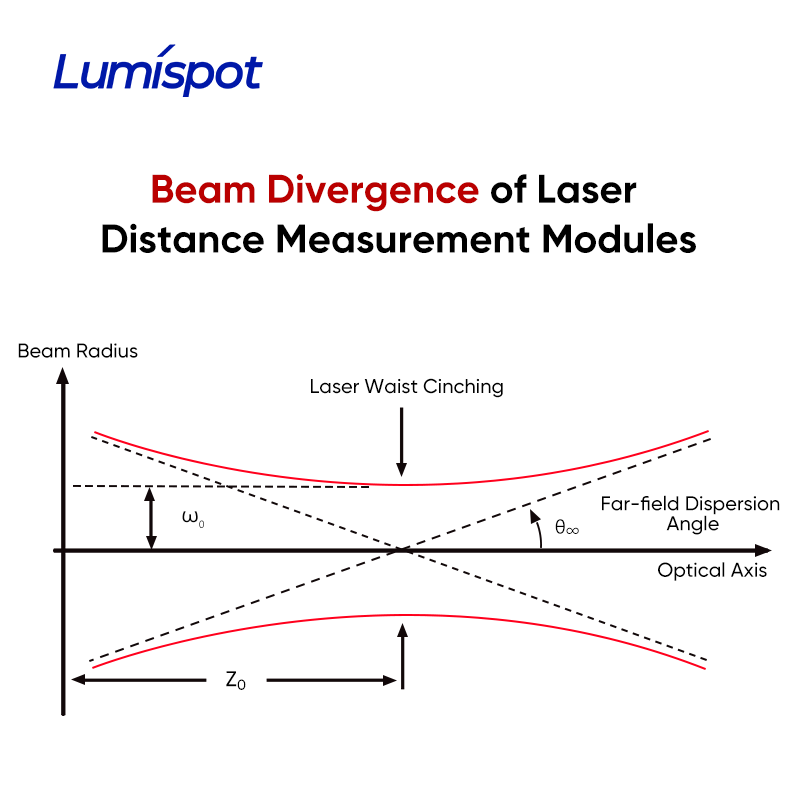Laser distance measurement modules are high-precision tools widely used in fields such as autonomous driving, drones, industrial automation, and robotics. The working principle of these modules typically involves emitting a laser beam and measuring the distance between the object and the sensor by receiving the reflected light. Among the various performance parameters of laser distance measurement modules, beam divergence is a crucial factor that directly affects measurement accuracy, measurement range, and the choice of application scenarios.
1. Basic Concept of Beam Divergence
Beam divergence refers to the angle at which the laser beam increases in cross-sectional size as it travels farther from the laser emitter. In simpler terms, the smaller the beam divergence, the more concentrated the laser beam remains during propagation; conversely, the larger the beam divergence, the wider the beam spreads. In practical applications, the beam divergence is usually expressed in angles (degrees or milliradians).
The divergence of the laser beam determines how much it spreads over a given distance, which in turn affects the spot size on the target object. If the divergence is too large, the beam will cover a larger area at long distances, which can reduce measurement accuracy. On the other hand, if the divergence is too small, the beam may become too focused at long distances, making it difficult to reflect properly or even preventing the receipt of the reflected signal. Therefore, selecting an appropriate beam divergence is crucial for the accuracy and application range of a laser distance measurement module.
2. Impact of Beam Divergence on Laser Distance Measurement Module Performance
Beam divergence directly affects the measurement accuracy of the laser distance module. A larger beam divergence results in a larger spot size, which can lead to scattered reflected light and inaccurate measurements. At longer distances, a larger spot size can weaken the reflected light, affecting the signal quality received by the sensor, thus increasing measurement errors. In contrast, a smaller beam divergence keeps the laser beam focused over longer distances, resulting in a smaller spot size and thus higher measurement accuracy. For applications requiring high precision, such as laser scanning and precise localization, a smaller beam divergence is generally the preferred choice.
Beam divergence is also closely related to the measurement range. For laser distance modules with large beam divergence, the laser beam will spread quickly over long distances, weakening the reflected signal and ultimately limiting the effective measurement range. Additionally, a larger spot size can cause reflected light to come from multiple directions, making it difficult for the sensor to accurately receive the signal from the target, which in turn affects measurement results.
On the other hand, a smaller beam divergence helps the laser beam remain concentrated, ensuring that the reflected light remains strong and thus extends the effective measurement range. Therefore, the smaller the beam divergence of a laser distance measurement module, the further the effective measurement range typically extends.
The choice of beam divergence is also closely tied to the application scenario of the laser distance measurement module. For scenarios requiring long-range and high-precision measurements (such as obstacle detection in autonomous driving, LiDAR), a module with a small beam divergence is typically chosen to ensure accurate measurements at long distances.
For short-distance measurements, scanning, or some industrial automation systems, a module with a larger beam divergence may be preferred to increase coverage area and improve measurement efficiency.
Beam divergence is also influenced by environmental conditions. In complex environments with strong reflective characteristics (such as industrial production lines or building scanning), the spreading of the laser beam may affect the reflection and reception of light. In such cases, a larger beam divergence can help by covering a larger area, increasing the strength of the received signal, and reducing environmental interference. On the other hand, in clear, unobstructed environments, a smaller beam divergence can help focus the measurement on the target, thus minimizing errors.
3. Selection and Design of Beam Divergence
The beam divergence of a laser distance measurement module is typically determined by the design of the laser emitter. Different application scenarios and requirements result in variations in beam divergence design. Below are several common application scenarios and their associated beam divergence choices:
- High Precision and Long-Range Measurement:
For applications requiring both high precision and long measurement distances (such as precise measurements, LiDAR, and autonomous driving), a smaller beam divergence is generally chosen. This ensures that the laser beam maintains a small spot size over longer distances, enhancing both measurement accuracy and range. For example, in autonomous driving, the beam divergence of LiDAR systems is typically kept below 1° to accurately detect distant obstacles.
- Large Coverage with Lower Precision Requirements:
In scenarios where a larger coverage area is required, but precision is not as critical (such as robot localization and environmental scanning), a larger beam divergence is typically chosen. This allows the laser beam to cover a wider area, enhancing the device’s sensing capabilities, and making it suitable for quick scanning or large-area detection.
- Indoor Short-Distance Measurement:
For indoor or short-range measurements, a larger beam divergence can help increase the laser beam’s coverage, reducing measurement errors due to improper reflection angles. In such cases, a larger beam divergence can ensure stable measurement results by increasing the spot size.
4. Conclusion
Beam divergence is one of the key factors affecting the performance of laser distance measurement modules. It directly influences measurement accuracy, measurement range, and the choice of application scenarios. Proper design of beam divergence can enhance the overall performance of the laser distance measurement module, ensuring its stability and efficiency across various applications. As laser distance measurement technology continues to evolve, optimizing beam divergence will become an important factor in extending the application range and measurement capabilities of these modules.
Lumispot
Address: Building 4 #, No.99 Furong 3rd Road, Xishan Dist. Wuxi, 214000, China
Tel: + 86-0510 87381808.
Mobile: + 86-15072320922
Email: sales@lumispot.cn
Post time: Nov-18-2024

